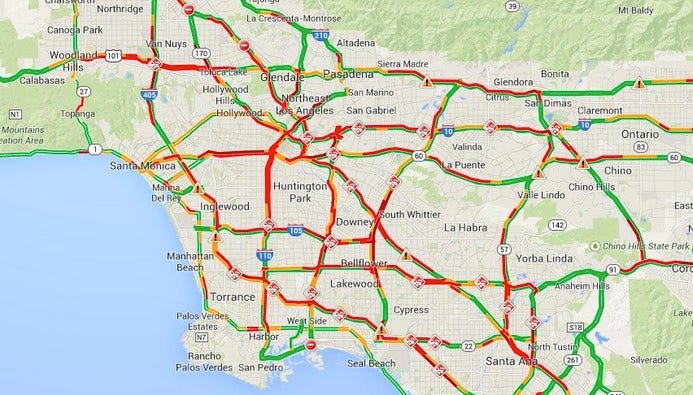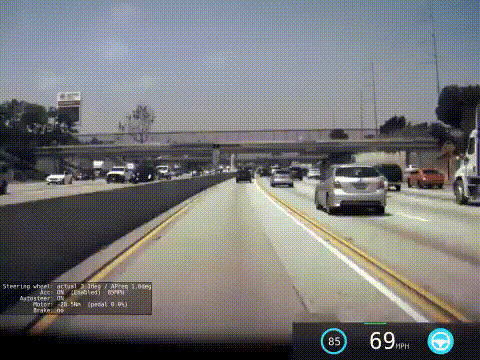Why the World Needs DIMO
DIMO allows users earn tokens for connecting vehicles to an open web3 IoT platform. We’re using this to bootstrap the next generation of mobility applications for electric and automated vehicles.
For more detail on what we’re building, you can start here, or connect your car.
This article explains why we think this project is important, and why the right time to build is now. Read on!
The last 30 years has provided a new set of overlays on our physical world:
- 🚧 Reliable Digital maps for every major road
- ⏩ Realtime data feeds for every mode of transport GTFS🚊 🚌, GBFS 🛴🚲 , FDX ✈/ OSN✈
- 🚗🚕 Ubiquitous ridehail & same-day delivery networks in every major city
- 📲 Portable Supercomputers (Phones) with built-in wallets 💳
These efforts have been a result of large, well-funded efforts by tech giants: Apple, Uber/Lyft, Google, and more. Unfortunately, their benefits are limited by existing infrastructure.

Digital innovations like ridehailing networks and google maps are centralized overlays on existing analog physical infrastructure. They haven’t changed the rules of how roads are built, energy is distributed, or traffic is routed.
- Transit and road infrastructure is more expensive per mile than ever.
- Crossing the Atlantic on a commercial flight takes longer than it did in 1985.
- Zero U.S. nuclear power plants have been commissioned in nearly 20 years.
- Traffic is more expensive and vehicle deaths are at the highest rates ever.
… and on top of it all we’re faced with the challenge of a lifetime — a rapidly warming planet.
What’s going on?
Centralized services like google and Amazon trying to optimize for individual user experiences can actually decrease system-level efficiency — traffic in New York got worse after Uber, and autonomous vehicles are likely to make this problem worse as the perceived cost of travel is reduced.
We’re also about to 10X the number of EVs on the road in the next 5 years, and autonomous vehicles are seemingly just around the corner. In the words of Tesla founder JB Straubel:
“It has the feeling to me of kind of like a giant overbooked flight. All these people are like, ‘Oh, this is great. We’re all gonna go to that new place. … Let’s all get on the plane and go’,” without building the aircraft, the runway or the air traffic control system.
It is clear that new a new model for funding and deploying digital infrastructure is needed for humans to realize the benefits of transport technologies like electrification and automation at scale.
Luckily, there is hope
A whole generation of networked, digitally native builders are entering their most productive years. They have been living in interactive, creator-first worlds — places like Roblox, Minecraft, and SimCity, and web3 open source projects like bitcoin and Ethereum.
A bipartisan supported infrastructure spending bill has passed in the U.S. — which means the largest economy in the world is going to spend $1T+ trying to build and buy the cars, bikes, roads and energy resources that give us a chance at a sustainable future.
A new wave of technologies is maturing:
- 🤖Robotic trucks and warehouses are ready for primetime.
- ⚡️Electric vehicles are the default choice for fleets of the future.
- 🛰 Starlink is covering the world with fast, cheap wireless.
- 📶Massive user-owned IoT networks like Helium are being proven out at scale.
- 🗼Traditional telecoms are rolling out 5G.
- 🛫 Drones and EVTOL aircraft (DJI, Lilium, Zipline) are hitting the skies.
Most importantly, models for building, financing, and maintaining public goods on the internet, at scale, are being developed:
It’s easier than ever to will something substantial into existence if you have the right tools.
- 👯♀️👩🏽🔬👨🏻🎨🙋🏽♂️ Gather a group of people with shared goals.
- 👩🏻💻💸👷🏼♀️🏗 Pool the cost of developing resources or services using a token.
- 📲 📈Distribute that to millions of people based on their contributions to a network.
Helium has built a user-owned telecom company with 300,000 (and counting) nodes in less than 2 years. Friends with Benefits has created a thriving community of over 2,000 curated members that mixes digital and in-person programming.
These networks are only limited by their ability to connect the digital and physical world. As a team with deep mobility, IoT, and automotive experience we’ve seen this problem, and we’re out to close this gap — allowing the web3 world to really start moving things around.
Open cyber-physical systems will unlock what we call the Trusted Machine Age, and we’re building towards this future with a shared set of goals & guiding principles:
📲 Users own & delegate access to connected devices, so they work for their owners, not the companies that built them.
🔗 Network participants own meaningful stakes in the platforms they use, coordinated by tokens and economic incentives.
👩🏫 Developers can build apps and services that compete on their merits, not on access to gated distribution channels.
🏛 Privacy and regulatory oversight can coexist under transparent rules.
🏗 The physical and digital public goods that support modern connected devices can be properly funded.
So, if we’re going to apply this model to mobility, where to begin? What is the right entry point?
Connected Vehicles
We might be biased because of our team’s industry experience, but we think cars are going to be The Biggest Developer Platform Yet — and therefore the most leveraged place to begin building open mobility infrastructure.
Modern cars produce an astounding amount of data: 2.5GB/hr, or ~1500x as much as web browsing. Automation and electrification will grow this number 100x — and carmakers (OEMs) are trying to build their own “Walled Garden” platforms, turning vehicles into the equivalent of Facebook accounts.
This information is increasingly being used to make safety-critical decisions, begging the question of who should have access to the data and controls, and under what circumstances those things should be shared.

Our team doesn’t pretend to have all the answers, but we have worked with these technologies at scale enough to know that a more open model is needed. Trust between hardware, software, infrastructure, operations and the public sector is only built through transparency and a shared understanding of the rules that govern complex systems like mobility.
We’re building DIMO to incorporate the groups that make this possible.
So who are these groups?
Currently developers are prevented from building useful applications for vehicles. This degrades consumer trust as vehicles combust, crash, or otherwise underperform without warning, leaving consumers at the mercy of auto manufacturers.
Open data and car enthusiasts have been organizing around open-source projects like OpenDBC to unlock vehicle data, and the “Right to Repair” movement has cemented their right to collect it. People want to use the data from their vehicles! In our view only the tooling and incentives are missing to scale this up to hundreds of millions of vehicles, and we’re here to do that.
Cities have been asserting their rights to regulate connected mobility services through congestion pricing and new tools like The Mobility Data Standard (MDS).
Web3 technologies like zero-knowledge proofs, combined with decentralized identity standards and verifiable credentials are now capable of addressing privacy objections to centralized regulation of mobility systems. Said in plain english — with the right tools, it’s possible to prove you’re following the rules without compromising your privacy.
Of course, Vehicle Owners need compelling products and services that allow them to move around more quickly, cheaply, and safely.
Our mission at DIMO is to advance how technology helps people connect with and move throughout the world. We’re going to be at this for a long time, and we’d love to have you along.
Ready to dive in?
Sign up to connect your car and join our early-access waitlist today.
Become part of the community
Join our Discord, follow @DIMO_network on twitter and if you’re interested in learning more about what we’re building, you can read the DIMO Deep-Dive.
Andy Chatham has spent 10 years in the mobility space operating some of the largest autonomous and electric vehicle fleets, and building software used by millions of passengers. Before DIMO, he worked for Transdev managing a team of hundreds working on Waymo—Google’s self-driving car division. He’s also worked across many other domains in the mobility world, helping transit and real estate partners leverage new technologies and deploy mobility-as-a-service solutions.